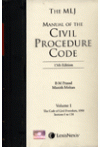- Author(s): B M Prasad, Manish Mohan
- Publisher: LexisNexis
- Edition: 15 Ed 2015
- ISBN 13 9789351433484
- Approx. Pages 5812 + contents
- Format Hardbound
- Approx. Product Size 24 x 16 cms
- Delivery Time 3-5 working days (within Kerala & South India) (Others 7-9 days)
- Shipping Charge Extra (see Shopping Cart)
............................................................................................................................
Description
The long-standing adage that "procedural law is subservient to substantive law" has indeed become otiose today when we have fresh law graduates getting appointed to preside the trial courts without any practical experience of the legal profession at the Bar. Indeed, the dispensation of justice can be a possible casualty if the procedural aspect of legal profession is not given adequate importance. This aspect has been succinctly explained in the following words: "Procedural law cannot betray the substantive law by submitting to subordination of complexity. Courts equipped with power to interpret law are often posed with queries which may be ultimate. The judicial steps of the Judge then do stir to solve novel problems by neat innovations. When the statute does not provide the path and precedents abstain to lead, then they are the sound logic, rational reasoning, common sense and urge for public good which play as guides of those who decide. Wrong must not be left unredeemed and right not left unenforced. Forum ought to be revealed when it does not clearly exist or when it is doubted where it exists."
Needless to say: ". ..a. procedural law is always in aid of justice, not in contradiction or to defeat the very object which is sought to be achieved. A procedural law is always subservient to the substantive law. Nothing can be given by a procedural law what is not sought to be given by a substantive law and nothing can be taken away by the procedural law what is given by the substantive law".
For understanding and explaining the procedural aspect of civil courts, the MLJ—Manual of the Civil Procedure Code has always had a pivotal role, due to its lucid manner of explaining the legal position as also the comparative case law. This work has always had an immense practical utility amongst the professionals as also amongst those who are in the process of imparting and receiving academic discourse.
............................................................................................................................
Contents
Voulme One
The Code of Civil Procedure, 1908
Preliminary
Part 1. Suits in General
Part 2. Execution
Part 3. Incidental Proceedings
Part 4. Suits in Particular Cases
Part 5. Special Proceedings
Part 6. Supplemental Proceedings
Part 7. Appeals
Part 8. Reference, Review and Revision
Part 9. Special Provisions Relating to the High Courts not Being the
Court of a Judicial Commissioner
Part 10. Rules
Part 11. Miscellaneous
Volume Two
First Schedule
Order 1. Parties to Suits
Order 2. Frame of Suits
Order 3. Recognized Agents and Pleaders
Order 4. Institution of Suits
Order 5. Issue and Service of Summons
Order 6. Pleadings Generally
Order 7. Plaint
Order 8. Written Statement, Set-off and Counter-Claim
Order 9. Appearance of Parties and Consequence of Non-appearance
Order 10. Examination of Parties by the Court
Order 11. Discovery and Inspection
Order 12. Admissions
Order 13. Production, Impounding and Return of Documents
Order 14. Settlement of Issues and Determination of Suit on Issues of
Law or on Issues Agreed upon
Order 15. Disposal of the Suit at the First Hearing
Order 16. Summoning and Attendance of Witnesses
Order 16A.Attendance of Witnesses Confined or Detained in Prisons
Order 17. Adjournment
Order 18. Hearing of the Suits and Examination of Witnesses
Order 19. Affidavits
Order 20. Judgment and Decree
Order 20A.Costs
Order 21. Execution of Decrees and Orders
Volume Three
Order 22. Death, Marriage and Insolvency of Parties
Order 23. Withdrawal and Adjustment of Suit
Order 24. Payment into Court
Order 25. Security for Costs
Order 26. Commissions
Order 27. Suits by or against the Government or Public Officers in their
Official Capacity
Order 27A.Suits Involving a Substantial Question of Law as to the Interpretation
of the Constitution or as to the Validity of any Statutory Instrument
Order 28. Suits by or against Military or Naval Men or Airmen
Order 29. Suits by or against Corporations
Order 30. Suit by or against Firms and Persons carrying on Business in
Names other than their own
Order 31. Suits or against Trustees, Executors and Administrators
Order 32. Suits by or against Minors and Persons of unsound Mind
Order 32A.Suits Relating to Matters Concerning the Family
Order 33. Suits by Indigent Persons
Order 34. Suits Relating to Mortgages of Immovable Property
Order 35. Interpleader
Order 36. Special Case
Order 37. Summary Procedure
Order 38. Arrest and Attachment before judgment - arrest before Judgment
Order 39. Temporary Injections and Interlocutory Orders
Order 40. Appointment of Receivers
Order 41. Appeals from Original Decrees
Order 42. Appeals from Appellate Decrees
Order 43. Appeals from Orders
Order 44. Appeals by Indigent Persons
Order 45. Appeals to the Supreme Court
Order 46. Reference
Order 47. Review
Order 48. Miscellaneous
Order 49. Chartered High Courts
Order 50. Provincial Small Cause Courts
Order 51. Presidency Small Cause Courts
Allied Acts
1. Arbitration and Conciliation Act,1996 (26 of 1996)
2. Indian Stamp Act,1899 (2 of 1899)
3. Legal Services Authorities Act,1987 (39 of 1987)
4. Letters Patent for the High Court of Allahabad
5. Letters Patent for the High Courts of Calcutta, Madras and Bombay
6. Letters Patent for the High Court of Lahore, Punjab, Haryana and Delhi
7. Letters Patent for the High Court of Nagpur (Madhya Pradesh)
8. Letters Patent for the High Court of Patna
9. Limitation Act, 1963 (36 of 1963)
10. Registration Act, 1908 (16 of 1908)
............................................................................................................................

